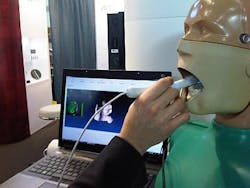3-D dental scanner wins VISION Award; commercial version to launch in 2012
| This 3-D dental scanner can produce a 3-D image of a full set of teeth in a few minutes. Initially developed at the Austrian Institute of Technology (AIT), the technology is slated for commercialization in 2012. (Image courtesy of AIT) |
A prototype 3-D scanner for digital dentistry, based on a continuous blue LED source and a pair of tiny cameras typically used in cell phones, has won the VISION Award 2011, a prize that recognizes new developments in the field of applied image processing. Manfred Gruber, head of the "safe and autonomous systems" business unit at the Austrian Institute of Technology (AIT; Vienna, Austria), accepted the award and the â¬5,000 prize at the annual VISION trade show in Stuttgart, Germany, this week.
The scanner, developed at AIT and being commercialized by start-up company a.tron3D (Klagenfurt, Austria), generates a 3-D image of a full set of teeth in just a few minutes. Although it isnât the first such optical scanner for such applications, it is the smallest and lightest, according to AIT and a.tron3D. Resembling a toothbrush and directly compatible with conventional dental tools, it is around half the size of similar tools already commercialized that require a patient to bite on silicone material before a mold of the impression is made.
The AIT-developed, real-time 3-D scanner relies on a miniaturized light projection system and advanced algorithms to produce the digital impression quickly while blue light is used, as it gives a better spectral response than longer wavelengths. The technique would not be effective with red wavelengths, for example, says AIT.
a.tron3D was founded in 2010 by dental laboratory owner Horst Koinig, who first came across AITâs development of 3D scanning technology at the same VISION trade show around five years ago. The companyâs âbluescan-1â product is currently at the advanced prototype stage, and set for commercialization and a manufacturing ramp next year. The company is also working on a 3-D face scanner using the same AIT technology, which could aid plastic surgeons with procedures such as facial reconstructive surgery.
As well as being smaller and cheaper, the miniaturized dental scanner ports directly to a standard USB connection and the 3-D models produced can be sent to any dental laboratory in the world for subsequent mold and impression production.
-----
Follow us on Twitter, 'like' us on Facebook, and join our group on LinkedIn
Follow OptoIQ on your iPhone; download the free app here.
Subscribe now to BioOptics World magazine; it's free!
